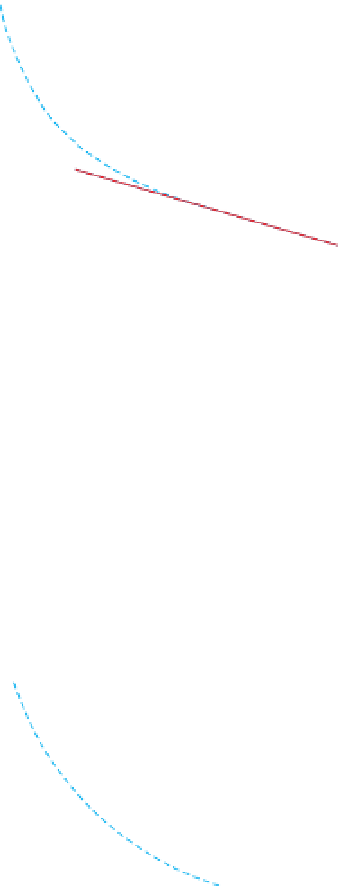Geoscience Reference
In-Depth Information
responses from the observed composite response, assum-
ing it is due only to the decaying secondary magnetic
fields,
is described in Decay analysis in
Section 5.7.5.3
.
a)
10
3
10
2
5.7.2.4
Current channelling
In conductive environments the target conductor is often
electrically connected to the conductive host rocks, and
possibly also to conductive overburden if present, allowing
current to flow between them and their individual eddy
current systems to interact. Also, and as described in
Diffusion depth in
Section 5.7.2.1
, diffusion in a highly
conductive background is slow. In this case, the conductor
is energised in a complex manner by three mechanisms:
the collapsing primary field of the loop, the varying mag-
netic field of the slow-moving half-space eddy current
system, and the half-space currents
10
1
= 7.4 ms
10
0
0
5
10
15
20
25
Time (ms)
b)
10
3
10
2
flowing through the
conductor in an effect known as current gathering or
current channelling. The
t
= 16.1 ms
10
1
fields are inextricably coupled.
Recall that current
flows via the path of least resistance
(see
Sections 5.3.1
and
5.6.1
)
, so current channelling only
occurs when the conductor is electrically connected to its
host rocks, and when the half-space current system is
passing through the region of the conductor. It is a func-
tion of the background conductivity and distance from the
loop to the conductor. In resistive environments it is likely
to be seen at early times and for a short time only as the
fast-moving background current system passes through,
but in conductive environments it persists for a longer
period. With increasing distance from the loop, induction
in the conductor becomes weaker, but the half-space eddy
currents can be stronger and dominate current
10
0
0
25
50
75
100
125
Time (ms)
c)
10
1
10
0
t
= 31 ms
10
-1
10
-2
0
20
40
60
80
100
ow
Time (ms)
through the electrically connected conductor.
Current channelling increases the amplitude of the
response for a surface receiver and broadens the anomaly
of the conductor, and produces a faster-decaying power-law
of poor conductors, but the strong responses it produces
makes it dif
cult to distinguish between poor and good
conductors. In highly conductive environments, current
channelling can completely obliterate the exponential decay
with the loss of diagnostic information about the conductor,
apart from identifying its location. In a similar way, the
expanding current system of a conductive overburden layer
can be the source of the channelling current.
A resistive body in conductive host rocks will de
ect the
half-space currents around and can produce a
Figure 5.81
Log
-
linear decay plots showing late-time exponential
decay due to target conductors. (a) Ernest Henry deposit, redrawn,
with permission, from Webb and Rowston (
1995
), (b) Trilogy
deposit, redrawn, with permission, from Sampson and Bourne
(
2001
), and (c) Eloise deposit, redrawn, with permission, from
(see
Section 5.7.7.1
and
Fig. 5.89
for additional information).
mid- to late times after the overburden and half-space
responses have diminished to reveal the slower-decaying
target response. This is evident in
Fig. 5.81
where the
exponential decay due to the conductive mineralisation is
only apparent at later times. Late-time measurements are
essential for exploring in conductive environments, but
poor conductors can remain undetected since their decay
may be too rapid to be evident after the overburden and
host rock responses have disappeared. Resolving individual
'
conductor
response
because of the increased current density in its
immediate surrounds.
'












































































































Search WWH ::

Custom Search